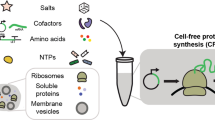Abstract
Heterogeneity of cell culture-produced glycoproteins often results from the presence or absence of a few sugars found on the terminus of glycoprotein oligosaccharides. Variability in bioprocess factors can potentially lead to variability in this oligosaccharide heterogeneity (1). Although stochastic events in the intracellular biosynthetic process have long been recognized as a cause of oligosaccharide heterogeneity (2), more recent data has demonstrated that extracellular degradation by glycosidases can also contribute to oligosaccharide heterogeneity (3,4). The purpose of this chapter is to introduce the concept and consequence of glycosidase degradation, to discuss methods for evaluating whether glycosidase degradation is significant for a particular process, and to provide some potential remedies to alleviate undesirable degradation.
Similar content being viewed by others
References
Andersen, D. C. and Goochee, C. F. (1994) The effect of cell-culture conditions on the oligosaccharide structures of secreted glycoproteins. Curr. Opin. Biotechnol. 5, 546–549.
Kornfeld, R. and Kornfeld, S. (1985) Assembly of asparagine-linked oligosaccharides. Annu. Rev. Biochem. 54, 631–664.
Gramer, M. J., Goochee, C. F., Chock, V. Y., Brousseau, D. T., and Sliwkowski, M. B. (1995) Removal of sialic acid from a glycoprotein in CHO cell culture supernatant by action of an extracellular CHO cell sialidase. Bio/Technology 13, 692–698.
Munzert, E., Muthing, J., Buntemeyer, H., and Lehmann, J. (1996) Sialidase activity in culture fluid of Chinese hamster ovary cells during batch culture and its effect on recombinant human antithrombin III integrity. Biotechnol. Prog. 12, 559–563.
Conzelmann, E. and Sandhoff, K. (1987) Glycolipid and glycoprotein degradation. Adv. Enzymol. 60, 89–216.
Goochee, C. F., Gramer, M. J., Andersen, D. C., Bahr, J. B., and Rasmussen, J. R. (1992) The oligosaccharides of glycoproteins: factors affecting their synthesis and their effect on glycoprotein properties, in Frontiers in Bioprocessing H (Todd, P., Sikdar, S. L., and Bier, M., eds.), American Chemical Society, Washington, DC, pp. 199–240.
Varki, A. (1993) Biological roles of oligosaccharides: all of the theories are correct. Glycobiology 3, 97–130.
Furbish, F. S., Steer, C. J., Krett, N. L., and Barranger, J. A. (1981) Uptake and distribution of placental glucocerebrosidase in rat hepatic cells and effects of sequential deglycosylation. Biochim. Biophys. Acta 673, 425–434.
Steer, C. J. and Clarenburg, R. (1979) Unique distribution of glycoprotein receptors on parenchymal and sinusoidal cells of rat liver. J. Biol. Chem. 265, 874–881.
Stockert, R. J., Morell, A. G., and Scheinberg, I. H. (1976) The existence of a second route for the transfer of certain glycoproteins from the circulation into the liver. Biochem. Biophys. Res. Commun. 265, 68, 988–993.
Winkelhake, J. L. and Nicolson, G. L. (1976) Aglycosylantibody: effects of exoglycosidase treatments on autochthonous antibody survival time in the circulation. J. Biol. Chem. 251, 1074–1080.
Donahue, R. E., Wang, E. A., Kaufman, R. J., Foutch, L., Leary, A. C., Witek-Giannetti, J. S., et al (1986) Effects of N-linked carbohydrate on the in vivo properties of human GM-CSF, Cold Spring Harbor Symp. Quant. Biol. 51, 685–692.
Murray, G. J. (1987) Lectin-specific targeting of lysosomal enzymes to reticuloendothelial cells. Methods Enzymol. 149, 25–42.
Fukuda, M. N., Sasaki, H., Lopez, L., and Fukuda, M. (1989) Survival of recombinant erythropoietin in the circulation: the role of carbohydrates. Blood 73, 84–89.
Gramer, M. J. and Goochee, C. F. (1991) Potential for degradation of glycoprotein oligosaccharides by extracellular glycosidases. AICHE National Meeting, Los Angeles, CA.
Gramer, M. J. and Goochee, C. F. (1993) Glycosidase activities in Chinese hamster ovary cell lysate and cell culture supernatant. Biotechnol. Prog. 9, 366–373.
Gramer, M. J., Schaffer, D. V., and Sliwkowski, M. B. (1994) Purification and characterization of α-l-fucosidase from Chinese hamster ovary cell culture supernatant. Glycobiology 4, 611–616.
Gramer, M. J. and Goochee, C. F. (1994) Glycosidase activities of the 293 and NS0 cell lines, and of an antibody-producing hybridoma cell line. Biotechnol. Bioeng. 43, 423–428.
Warner, T. G., Chang, J., Ferrari, J., Harris, R., McNerney, T., Bennett, G., et al. (1993) Isolation and properties of a soluble sialidase from the culture fluid of Chinese hamster ovary cells. Glycobiology 3, 455–463.
Licari, P. J., Jarvis, D. L., and Bailey, J. E. (1993) Insect cell hosts for baculovirus expression vectors contain endogenous exoglycosidase activity. Biotechnol. Prog. 9, 146–152.
Sliwkowski, M. B., Gunson, J. V., and Warner, T. G. (1992) Sialylation and phosphorylation as a function of culture conditions for recombinant human deoxyribonuclease produced by CHO cells. J. Cell. Biochem. 16(Suppl.), 150.
Warner, T. G. and O’Brien, J. S. (1979) Synthesis of 2′-(4-methylumbelliferyl-α-d-N-acetylneuraminic acid and detection of skin fibroblast neuraminidase in normal humans and in sialidosis. Biochemistry 18, 2783–2787.
Hardy, M. R., Townsend, R. R., and Lee, Y. C. (1988) Monosaccharide analysis of glycoconjugates by anion-exchange chromatography with pulsed amperometric detection. Anal. Biochem. 170, 54–62.
Starr, C., Masada, R. I., Hauge, C., Skop, E., and Kock, J. (1996) Fluorophore-assisted-carbohydrate-electrophoresis, FACE, in the separation, analysis, and sequencing of carbohydrates. J. Chromatogr. 720, 295–321.
Skoza, L. and Mohos, S. (1976) Stable thiobarbituric acid chromaphore with dimethyl sulphoxide. Biochem J. 158, 457–321.
Urbanowski, J. C., Wunz, T. M., and Dain, J. A. (1980) A colorimetric procedure for measuring the enzymatic hydrolysis of terminal galactose from GM1 ganglioside. Anal. Biochem. 105, 461–467.
Cohenford, M. A., Abraham, A., Abraham, J., and Dain, J. A. (1989) Colorimetric assay for free and bound l-fucose. Anal. Biochem. 177, 172–177.
Minch, S. L., Kallo, P. T., and Balley, J. E. (1995) Tissue plasminogen activator expressed in Chinese hamster ovary cells with α(2,6)Galβ(1,4)GlcNAc-R linkages. Biotechnol. Prog. 11, 348–351.
Sato, K. and Miyagi, T. (1996) Involvement of an endogenous sialidase in skeletal muscle cell differentiation. Biochem. Biophys. Res. Commun. 221, 826–830.
Ferrari, J., Lofgren, G. J., Krummen, L., T. G. (1998) Chinese hamster ovary cells with constitutively expressed sialidase antisense RNA produce recombinant DNase in batch culture with increased sialic acid. Biotechnol. Bioeng 60, 589–595.
Author information
Authors and Affiliations
Corresponding author
Rights and permissions
About this article
Cite this article
Gramer, M.J. Detecting and minimizing glycosidase activities that can hydrolyze sugars from cell culture-produced glycoproteins. Mol Biotechnol 15, 69–75 (2000). https://doi.org/10.1385/MB:15:1:69
Issue Date:
DOI: https://doi.org/10.1385/MB:15:1:69




